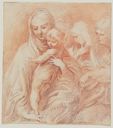Madonna and Child with Three Holy Women
Artist: Tommaso Redi (after Parmigianino) (Italian, 1665-1726)
Medium: red chalk, rubbed areas on paper
Dimensions: 8 3/8 in. x 7 3/8 in. (21.2 cm. x 18.8 cm.)
Credit Line: Bequest of the Honorable James Bowdoin III
Accession Number: 1811.31
- Paschal lamb in double circle
Type: watermark
Location:
Materials: - "No. 68 Thomas Redi"
Type: inscription
Location: verso of mount (now removed)
Materials: pen and ink
- John Smibert (?)( Artist and Collector, ) - .
- James Bowdoin III( Collector, Boston) - 1811.
- Bowdoin College Museum of Art( Museum, Brunswick, Maine) 1811- . Bequest
- Old Master Drawings at Bowdoin College
- Bowdoin College Museum of Art. ( 5/17/1985 - 7/7/1985)
- Clark Art Institute. ( 9/14/1985 - 10/27/1985)
- University of Kansas. ( 1/19/1986 - 3/2/1986)
- Art Gallery of Ontario. ( 5/17/1986 - 6/29/1986)
- Drawing on Basics
- Bowdoin College Museum of Art. ( 10/14/1993 - 12/19/1993)
Type: catalogue Author: Henry Johnson Document Title: Catalogue of the Bowdoin College Art Collections Publ. Place: Brunswick, Maine Reference: no. 41 Section Title: Pt. I, The Bowdoin Drawings Date: 1885 Type: catalogue Author: Bowdoin College Museum of Art Document Title: Bowdoin Museum of Fine Arts, Walker Art Building Edition: 4th Publ. Place: Brunswick, Maine Reference: no. 41 Publisher: Bowdoin College Section Title: Descriptive Catalogue of the . . . Date: 1930 Type: exhibition catalogue Author: David P. Becker Document Title: Old Master Drawings at Bowdoin College Publ. Place: Brunswick, Maine Location: pp. 174-175 Reference: 81 (illus.) Publisher: Bowdoin College Date: 1985
This sheet bears a traditional attribution to Redi. The comparative rarity of drawings by him lends credence to the inscription, particularly since a logical attribution would have been to the originator of the design – Parmigianino. As Philip Pouncey, in conversation with David P. Becker, was the first to point out, the Bowdoin drawing is a close copy of a Parmigianino sheet, also in red chalk, in the Uffizi (fig. 1). Chiara d’Affilito confirmed the Redi attribution and the style of the Bowdoin drawing as close to a figure study securely attributed to Redi in the National Gallery of Scotland (fig. 2).
John Smibert probably acquired this drawing for his collection directly from the artist. He is known to have visited Redi on May 25, 1720, and purchased a "pictor of his" (Evans, Kerslake, and Oliver, 100). Perhaps Smibert was particularly interested in buying a reproduction of a design by Parmigianino, as originals may have been difficult to procure. Stefano Mulinari (ca. 1741–ca. 1790), a printmaker, produced an etching of the Parmigianino drawing, but after Redi's death. Redi himself was employed to copy other old master drawings for reproduction as prints for the French collector Pierre Crozat (1665–1740) according to a letter from the Florentine collector and scholar Francesco Maria Niccolò Gabburri (Viatte and Monbeig-Goguel, 230).
David P. Becker (edited by Sarah Cantor)
References:
Evans, Sir David, John Kerslake, and Andrew Oliver. The Notebook of John Smibert. Boston: Massachusetts Historical Society, 1969.
Viatte, François, and Catherine Monbeig-Goguel. Dessins baroques florentins du Musée du Louvre. Paris: Ministère de la culture, Editions de la Réunion des musées nationaux, 1981.
Images:
Fig. 1: Parmigianino Madonna and Child with Three Holy Women, Gabinetto Disegni e Stampe degli Uffizi, Florence 1976 F
Fig. 2: Tommaso Redi, National Gallery of Scotland, Edinburgh
Artist Biography:
Tommaso Redi studied with Anton Domenico Gabbiani (1652-1726), court painter to Grand Duke Cosimo III de’Medici from the age of eighteen. In 1690 he was sent to Rome on a stipend from Cosimo III to continue his studies with Carlo Maratti (1625-1713) and Ciro Ferri (1634-89). Ten years later, he returned to Florence, and remained there until his death. Redi executed religious paintings for churches and houses in and near Florence; he was often commissioned by visiting English nobility on the Grand Tour to paint mythological and historical subjects. He also worked for the Danish and Russian courts, training artists from the latter at the request of Tsar Peter the Great.
David P. Becker (edited by Sarah Cantor)
Commentary credited to David P. Becker (or not otherwise captioned) appeared in his catalogue Old Master Drawings at Bowdoin College (Brunswick: Bowdoin College Museum of Art, 1985).


 Museum of Art
Museum of Art